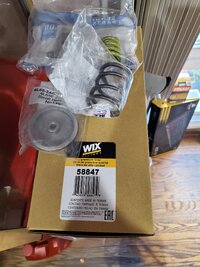- Apr 9, 2012
- 912
Brother that's *WILD*, those spectacles you surveyed all sound full of malaise. I congratulate you on not accepting tetanus frames, and effectively dismissing that crapola pre-emptively.
I know it was going to be hard finding one, but damn I didn't realize exactly how difficult it was going to be finding one in decent shape. Like, yeah the platform is old, and nothing is "perfect" but these people are absolutely nuts thinking they can list their junk in "good" shape/condition and expect top dollar for it. We're holding off on searching, letting time takes its course and see what pops up down the line. Its been an exhausting almost 1 month long venture.
Not a whole lot done with the Envoy since last update. Bought new Bosch wiper blades, got 3 years out of the other set which is great! Pricey, but worth it when they don't need to be swapped out every 6 months. The hard 1-2 shift is coming back. It cleared up for awhile, but I suspect now that the PCM/TCM have re-learned themselves it's settled back into that condition. Its more intermittent, like it'll be somewhat firm some days, and then once you're at 30-40% throttle its very firm. I'm terrible at describing it, but if you had the level 1 shift from the PCM tune it roughly hovers between a 1.5-2 on the firmness level.
I'm still certain the 1-2 accumulator housing and piston are in good shape, only thing I can think of that "could" be a potential culprit is the Sonnax Purple Accumulator Spring I installed prior to the Transgo kit. When I purchased everything for the install, Sonnax had the spring listed as being like the OE Green one. However, when squeezing them (the old green one) in hand the Sonnax felt much more firmer. So I my guess is the Sonnax is too firm on its own, and requires the inner smaller spring to provide the cushion (?) during the shift. So I ordered the AC Delco Green Outer, and Yellow Inner to install. If that still doesn't resolve it, I guess the issue lies somewhere in the valve body since this didn't happen until after the kit, or something is wrong with a component from the kit and this is the result. I'd drop the valve body myself, but I don't feel too confident messing with it this time around without additional hands/someone more familiar with the install/removal/inner workings of it.
Which leads into my next question, I know May03LT made a video a while back on how to do a "flush" on the transmission. I think it was a Tahoe, where he dumped 4 quarts with the truck running with the front cooler line disconnected and proceeded to do it in 4 quart and fill increments until the fluid came out clean. Is this still the preferred method? My fluid is still clean, and was clean prior to the install and when I go the truck. I'll need to recheck the service records, but it looks like the tranny had a normal pan/drop schedule. So if I'm dropping the pan, I might as well consider just getting the system replenished entirely with Dex VI maxlife fluid.

